


Organic leadership is as old as human life itself. We're evolved to do it genetically and culturally. Even where the bureaucratic machine model of organisation is dominant, the natural system exists in parallel. We are doing it already because it is human nature. Our task is to uncover what people are successfully doing and to help them thrive.
Successful businesses are agile organisms which adapt to their ecological niche. Like a giant ant's nest, beehive, wildebeest migration or shoals of fish, human beings align and coordinate using an inner map and compass:
- This who we are, where come from, where we are and where we're going.
- This is what we care about, what we believe and what we are trying to achieve.
- This is how we serve our customers needs and how we do business.
- This is good and bad, right and wrong, true and false.
You can perceive the map about an inch behind the forehead. The best leaders successfully navigate the territory using their inner compass of logic, reason, intellect, heart, gut, instinct, intuition, emotions, energy, social and spiritual intelligence.
The challenge with more complex organisations is to keep the formal structures and processes as closely aligned to the informal natural human system as possible. The benefits of this are that people are happier, healthier, more effective, better motivated and the organisation is much more adaptable. When treated as human beings, people become more engaged, present and connected. They use their common sense and judgement. They find alignment between their personal values and organisational values.
Our programme of workshops, interviews, surveys and a whole system conference ask the question "How can we optimise the leadership of this business?" We facilitate the leaders to discover what you are already doing successfully and distill the best practices, leadership behaviours and culture. We take our clients through a journey which harnesses the group intelligence of the leaders, staff and stakeholders of a business to imagine leadership at its very best, identify what is needed to make that happen, how to measure it and how to implement it. There is the option to discover and implement Authentic Performance Measures for the performance management of leadership.
For example, here are the recommendations arising from our work with a military organisation with 40 leaders of 13 units with 400 staff serving 250,000 service people:
1. Put one person in charge of each business unit
2. Empower leaders with mission command, functional authority and autonomy
3. Hold leaders accountable by measuring Leadership, Teamwork & Performance
4. Establish a Clear Chain of Command up & down
5. Clarify roles & responsibilities
6. Select and develop leaders by meritocracy
7. Establish Leadership assessment, training & coaching
8. Recognise and reward success; manage underperformance
9. Treat people compassionately as human beings
10. Engage & empower staff
11. Promote a culture of learning, fairness and respect
12. Communicate clearly, ideally in person
13. Things individuals can do to improve their leadership
14. Acknowledge and respond to low morale, burnout, cynicism and stress

1. Preparation
- We interview a sample of leaders & stakeholders to get a feel for the state of play and will ask the client to bring us up to speed with the context, priorities and issues.
2. Workshop- Introduction, Diagnosis & Appreciative Inquiry
- Attendance- leaders, managers and senior stakeholders
- Introduction to the Leadership Development Workshops
- Identify the current major problems and challenges for the leadership
- Introduction to Appreciative Inquiry method (see below)
- What's working well in the leadership?
- What are the strengths of the leadership at its best?
- Examples of success and good practice in the leadership
- Examples of effective interventions to improve the leadership
- Potential ideas to improve the leadership
- Envisage optimal leadership
- Authentic Performance Measures for leadership
3. Staff & stakeholder interviews and survey
- Survey
- All staff, leaders and selected customers and stakeholders
- How can we improve leadership?
- Interview a wide and deep sample of colleagues and stakeholders to discover:
- Examples of success and good practice in the leadership
- Examples of effective interventions to improve the leadership
- Potential ideas to improve the leadership
- Envisage optimal leadership
- Authentic Performance Measures for leadership
4. Whole System Conference "How can we optimise the leadership?"
- Attendance: all or a large sample of the leaders, staff, customers, stakeholders
- 1 day facilitated self-organising conference using Open Space Technology (See below) to harness the whole system intelligence to answer the question "How can we optimise our leadership?"
- Whole group to give written answer to "Using your own personal and professional judgement, how do you know if the business is well led?"
- Outputs
- Fresh ideas, worked up, tested, recorded, presented
- For each individual:
- Things that I (each individual leader) can do to improve leadership
- Things that We (each team) can do to improve leadership
- Things that the leadership/HQ can do to improve leadership
- Commitments to action:
- Things I will do differently
- Things I will invite my team to do differently
- Things I will propose to the leadership/HQ
- Ready-made groups of volunteers willing to staff the ideas selected
- Data for Authentic Performance Measures for the leadership
5. Workshop- Choose & develop the best ideas
- Attendance- leaders, managers and senior stakeholders
- To distill and harvest the best actionable ideas from the Whole System Conference
- To present and discuss the results of their Appreciative Inquiry interviews
- Invite volunteer individuals or teams to work up the ideas into practical proposals
6. Workshop- Practical Proposals Presented & Tested
- Attendance- senior leaders, managers and senior stakeholders
- Things that I (each individual leader) will do to improve leadership and teamwork
- Things that We (each team) will do to improve leadership
- Things that leadership/HQ can do to improve leadership
- Teams to develop and present their proposed interventions to the group
- Group to constructively critically appraise the viability of the proposed ideas
7. Report prepared and presented
- Each leader and group to write up their practical proposals
- Collate into a report with findings and recommendations
- Report submitted to the HQ, all leaders and, if deemed appropriate, the whole staff and stakeholders
8. Action
- HQ to decide which of the things that leadership/HQ can do to improve leadership and to implement as chosen
- HQ to decide whether to implement the Authentic Performance Measures for leadership
- Each individual leader to do to what they have committed to do
- Each team to decide which of the things that they can do to improve leadership and teamwork and to implement as chosen
Adan's executive coaches have decades of experience working at the executive level with leading organizations around the world. We have expertise in leadership, productivity, organizational change, team building, marketing, sales and motivation.
Our on-the-job experience coupled with extensive knowledge of the markets and functional areas enables us to deliver a variety of practical, high-impact presentations that engage, enlighten and entertain.


